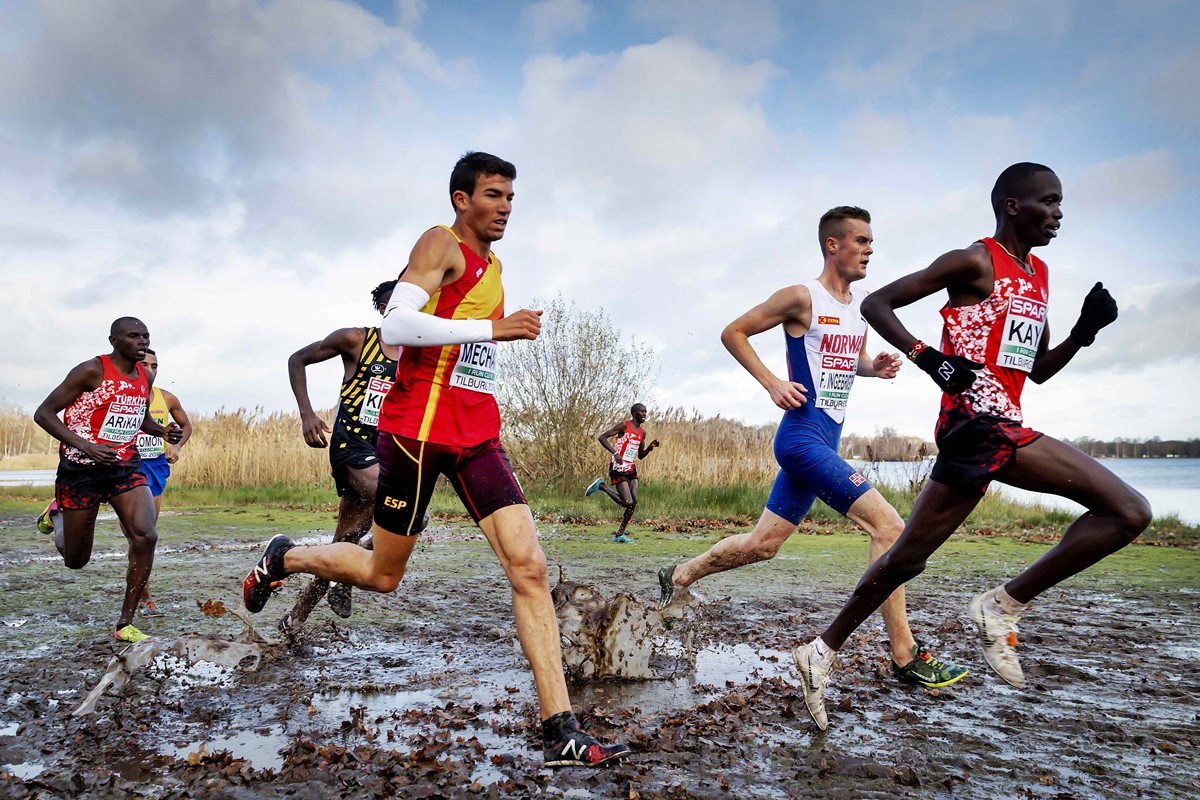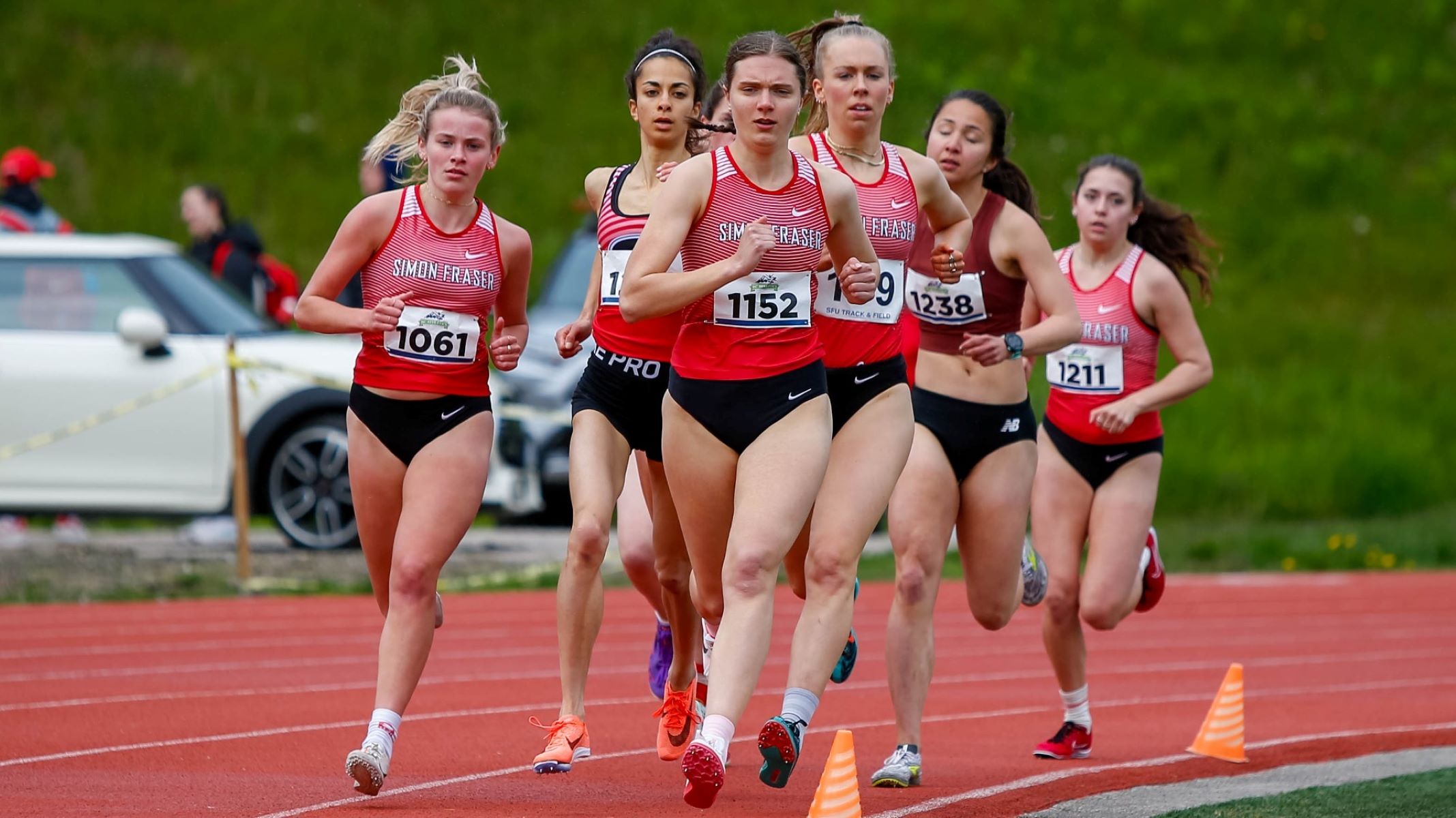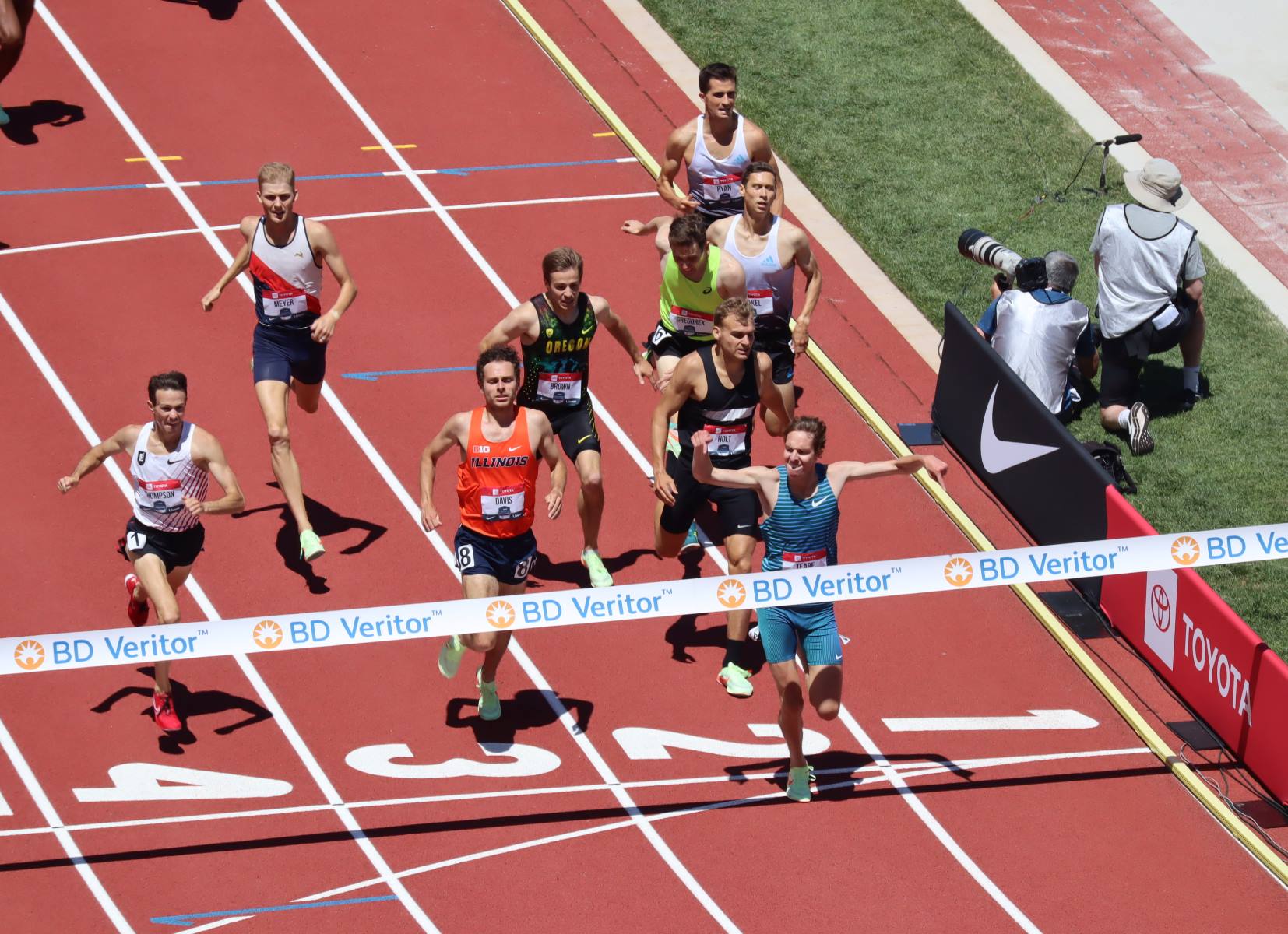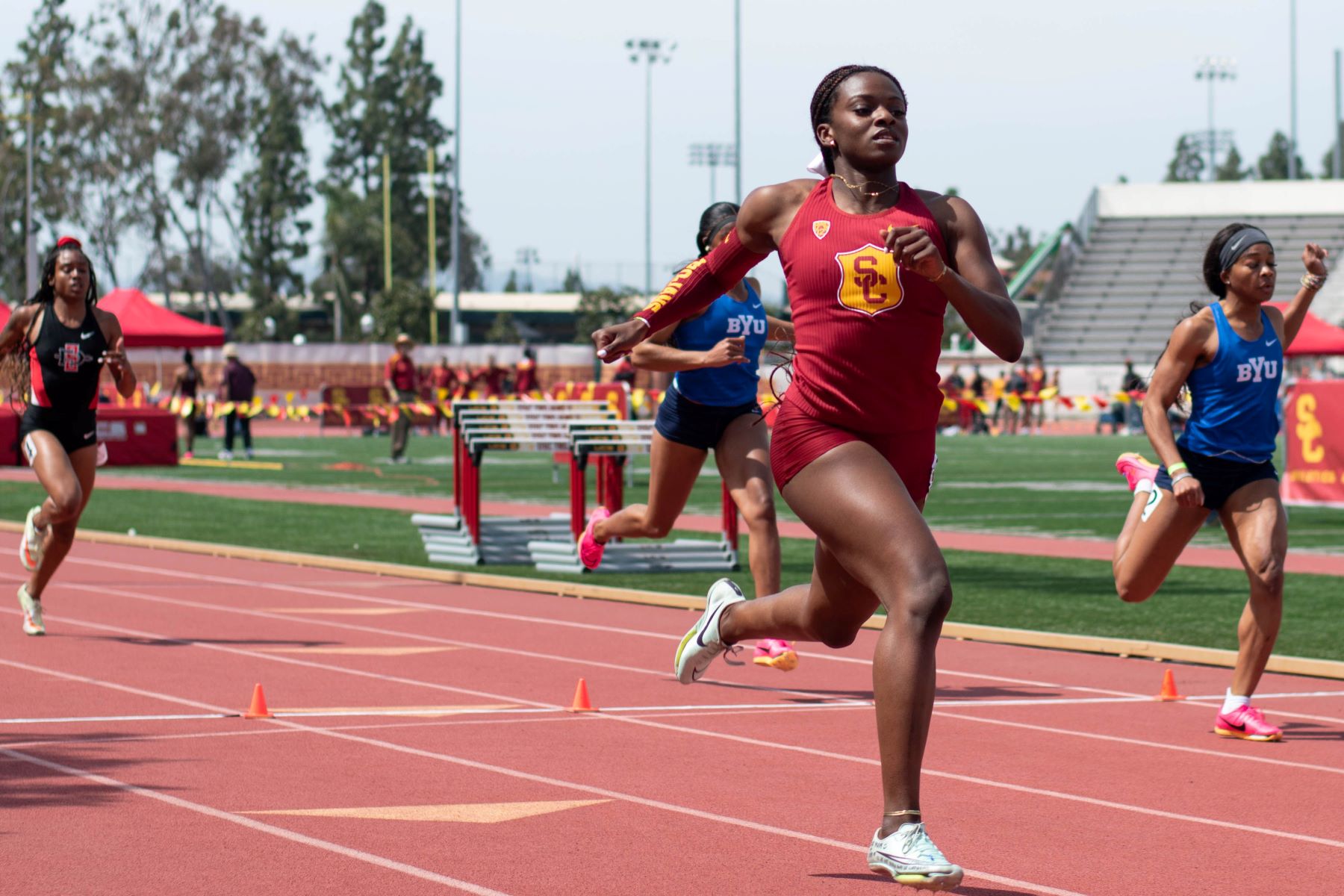

Featured
How To Win Track And Field
Published: November 12, 2023
Learn how to win in track and field with our featured tips and techniques. Improve your performance and achieve success on the track.
Introduction
Track and field is a dynamic and exhilarating sport that showcases the incredible athleticism and skills of athletes. From sprinting and jumping to throwing and distance running, this sport encompasses a wide range of events. Whether you’re a beginner looking to get involved in track and field or an experienced athlete looking to improve your performance, this article will provide you with valuable insights and tips on how to succeed in the sport.
Track and field is not just about physical strength and speed; it also requires mental focus, discipline, and strategic planning. It challenges athletes to push their limits, overcome obstacles, and continually strive for improvement. By understanding and implementing various training techniques and strategies, you can optimize your performance and achieve success in your chosen events.
In this article, we will guide you through the journey of becoming a successful track and field athlete. We will explore how to identify your event, set realistic goals, develop a training plan, improve your endurance and speed, master technique, prepare mentally, and take care of your body through proper nutrition, hydration, injury prevention, and recovery. Additionally, we will provide strategies for competing effectively and ways to analyze and adjust your performance.
Whether you dream of standing on the Olympic podium or simply want to improve your personal best, this article will equip you with the knowledge and tools to achieve your track and field goals. So, let’s dive in and discover how to excel in the exhilarating world of track and field!
Finding Your Event
Track and field offers a wide range of events to cater to different strengths and interests. Before diving into training, it’s important to find the event that suits you best. Here are some tips to help you identify your event:
1. Assess Your Abilities: Take some time to assess your strengths and weaknesses. Are you naturally fast and explosive? Do you have good endurance? Are you more inclined towards jumping or throwing? Understanding your natural abilities can help you narrow down the events that align with your strengths.
2. Experiment and Try New Things: Don’t be afraid to try different events to find the one that resonates with you. Participate in school track and field team practices or local club events to get a taste of different events. This hands-on experience will give you valuable insights into what you enjoy and excel at.
3. Seek Guidance: Consult with experienced coaches or trainers who can assess your physical attributes and guide you towards events that suit your abilities. They can provide valuable advice on event selection based on your body composition, strengths, and athletic potential.
4. Consider Personal Preferences: Think about the events that excite and motivate you the most. Perhaps you enjoy the short bursts of speed in the sprint events, or you thrive on the mental and physical challenge of long-distance running. Taking your personal preferences into account can help you find an event that you are passionate about, increasing your motivation and enjoyment in training.
5. Evaluate Progress and Feedback: Once you have chosen an event, pay attention to your progress and seek feedback from coaches and trainers. Reflect on whether you are improving and if you feel a sense of fulfillment and accomplishment in your chosen event. Recognizing your progress and seeing positive results can further fuel your passion and dedication.
Finding your event in track and field is a process of self-discovery and exploration. Don’t be discouraged if it takes time to find the event that truly resonates with you. Be open-minded, experiment with different events, and seek guidance and feedback along the way. Remember, the key is to choose an event that matches your abilities, interests, and passion, setting the stage for a successful track and field journey.
Setting Goals
Setting goals is a crucial part of your track and field journey. Well-defined goals provide direction, motivation, and a sense of purpose in your training. Here’s how you can set effective goals to propel you towards success:
1. Be Specific: Set clear and specific goals that outline what you want to achieve. For example, instead of setting a vague goal like “improve my speed,” set a specific goal like “reduce my 100-meter sprint time by 0.5 seconds.”
2. Make Them Measurable: Quantify your goals so that you can track your progress. This could include setting targets for distances, times, heights, or weights. Having measurable goals allows you to gauge your improvement accurately.
3. Set Realistic and Achievable Goals: While it’s important to aim high, it’s equally crucial to set goals that are attainable. Assess your current abilities and progress to set goals that challenge you without being overwhelming. Gradually push your limits as you improve.
4. Establish Short-Term and Long-Term Goals: Break down your goals into short-term and long-term objectives. Short-term goals can be achieved within a few weeks or months, while long-term goals may take several months or even years. Having both types of goals helps you stay focused and motivated throughout your track and field journey.
5. Make Them Time-Bound: Assign a timeframe to each goal to create a sense of urgency and accountability. This will help you structure your training and track your progress more effectively.
6. Create Tiered Goals: To avoid feeling overwhelmed, set a hierarchy of goals. Start with small, achievable goals and gradually progress to more challenging ones. Celebrate your accomplishments along the way, as each milestone will motivate you to keep pushing forward.
7. Make Them Personal: Your goals should align with your own aspirations and desires, not just what others expect from you. Ensure that the goals you set are meaningful and fulfilling to you personally. This will fuel your determination and perseverance.
8. Write Them Down and Review Them Regularly: Put your goals in writing, whether in a journal or on a vision board. Review them frequently to remind yourself of what you’re working towards and to stay focused and committed to your track and field journey.
By setting well-defined, measurable, realistic, and time-bound goals, you will have a clear roadmap to guide your training and measure your progress. Goals provide you with motivation, focus, and a sense of accomplishment as you work hard to achieve them. Remember, your goals should challenge you while being attainable, and they should inspire and drive you towards success in track and field.
Developing a Training Plan
A well-structured training plan is essential to enhance your performance and reach your track and field goals. Here’s a step-by-step guide to help you develop an effective training plan:
1. Assess your Fitness Level: Before designing your training plan, assess your current fitness level and identify any areas that require improvement. This self-assessment will help you understand your strengths and weaknesses, allowing you to tailor your training to address specific needs.
2. Set Training Frequency: Determine how often you can train per week and set a consistent schedule. The frequency will depend on your availability, commitments, and recovery ability. Aim for a balance that allows you to push your limits while ensuring adequate rest and recovery.
3. Include Variety: Incorporate a variety of training methods and exercises to enhance different aspects of your performance. This could include endurance training, speed work, strength training, plyometric drills, and technique-focused sessions. Adding variety will keep your training interesting and prevent plateaus in progress.
4. Focus on Periodization: Divide your training plan into periods or phases, each with specific goals and emphasis. This technique, known as periodization, helps prevent overtraining and optimizes performance gains. Periodize your training by incorporating base training, strength training, speed training, and tapering phases leading up to competitions.
5. Gradually Increase Intensity: Avoid sudden, drastic increases in training intensity, as this can lead to injuries or burnout. Gradually progress the intensity of your workouts over time to allow your body to adapt and minimize the risk of overuse injuries.
6. Incorporate Recovery Days: Rest and recovery are just as important as intense training sessions. Schedule regular rest days to allow your body to regenerate and prevent fatigue or overtraining. Recovery days can include light cross-training activities or complete rest.
7. Listen to Your Body: Pay attention to your body’s signals and adjust your training plan accordingly. If you’re feeling fatigued or experiencing pain, take a step back and modify your training volume or intensity. Pushing through excessive fatigue or pain can lead to injuries and setbacks.
8. Seek Professional Guidance: If you’re new to track and field or looking to reach higher levels of performance, consider seeking guidance from a knowledgeable coach or trainer. They can help you create a personalized training plan based on your goals, abilities, and event specialization.
A well-designed training plan will provide structure, focus, and progression in your track and field journey. By assessing your fitness level, incorporating variety, focusing on periodization, and listening to your body, you will optimize your training and set yourself up for success in your chosen events.
Building Endurance
Endurance is a fundamental component of success in track and field events, as it allows you to sustain a high level of performance over long distances or periods of time. Here are some strategies to help you build endurance:
1. Long Distance Running: Incorporate regular long distance runs into your training regime. Gradually increase the distance covered each week to challenge your cardiovascular system and improve your aerobic capacity.
2. Interval Training: Integrate interval training sessions into your workouts. Alternate between periods of high-intensity running and recovery periods to improve your cardiovascular fitness and endurance. For example, perform 400-meter or 800-meter intervals at a faster pace followed by a slower jog or walk for recovery.
3. Tempo Runs: Tempo runs involve running at a comfortably hard pace for a sustained period of time. They help improve your lactate threshold, allowing you to sustain a faster pace for longer periods. Start with shorter tempo runs and gradually increase the duration and intensity over time.
4. Cross-Training: Engage in cross-training activities such as cycling, swimming, or rowing to supplement your running workouts. These activities provide additional cardiovascular conditioning and help prevent overuse injuries. Aim for two to three cross-training sessions per week.
5. Hill Training: Incorporate hill repeats into your training routine to build strength and improve endurance. Find a challenging hill and run uphill at a steady pace, focusing on good form and effort. Recover by jogging or walking downhill before repeating the uphill portion.
6. Circuit Training: Combine cardiovascular exercises, bodyweight exercises, and strength training exercises into a circuit format. This type of training helps improve cardiovascular fitness while developing overall muscular endurance. Perform a series of exercises with minimal rest in between.
7. Progressive Overload: Gradually increase the duration, intensity, or distance of your workouts to progressively overload your body. This progressive approach forces your cardiovascular system to adapt and improve over time.
8. Rest and Recovery: Allow for adequate rest and recovery between workouts to optimize endurance gains. This includes getting enough sleep, fueling your body with proper nutrition, and incorporating active recovery activities such as light jogging or stretching.
Building endurance is a gradual process that requires consistency and patience. By incorporating a variety of training techniques, gradually increasing the intensity, and taking care of your body through rest and recovery, you will enhance your cardiovascular fitness and stamina, enabling you to perform at your best in track and field events.
Improving Speed and Agility
Speed and agility are essential components of success in track and field, allowing athletes to perform at their best and outpace their competitors. Here are some strategies to help you improve your speed and agility:
1. Sprint Training: Incorporate sprint intervals into your training routine to improve your speed. Perform short sprints of 30 meters to 200 meters at maximum effort, focusing on good sprint mechanics and explosiveness. Rest and recover fully between each sprint to maintain quality.
2. Plyometric Exercises: Plyometric drills such as bounding, box jumps, and skipping can help enhance your explosive power and agility. These exercises engage your fast-twitch muscle fibers and improve your ability to generate quick and powerful movements.
3. Agility Drills: Include agility drills that involve rapid changes of direction, such as ladder drills, cone drills, and shuttle runs. These exercises improve your coordination, reaction time, and ability to change direction quickly, mimicking the movements required in track and field events.
4. Technique Work: Pay attention to your running technique and form. Proper arm swing, foot strike, and body posture can significantly contribute to improved speed and efficiency. Work with a coach or trainer to identify any technical flaws and implement corrective exercises and drills.
5. Strength Training: Building strength through exercises like squats, lunges, and deadlifts can support speed development. Focus on compound movements that engage multiple muscle groups and develop lower body strength, which is crucial for explosive speed.
6. Interval Training: Implement interval training sessions to improve both speed and endurance. Alternate between periods of high-intensity running or sprinting and recovery periods. This type of training enhances your body’s ability to maintain a fast pace over a prolonged effort.
7. Reaction Drills: Incorporate reaction drills to improve your reflexes and explosiveness, which are vital for quick starts and acceleration. Use visual or auditory cues to initiate a sprint or change of direction, challenging your reaction time and explosiveness.
8. Proper Warm-up: Prioritize a dynamic warm-up routine that includes dynamic stretches, mobility exercises, and short bursts of running. This prepares your body for the demands of speed and agility training and reduces the risk of injury.
Improving speed and agility in track and field requires a combination of targeted training, proper technique, and overall strength development. By incorporating sprint training, plyometric exercises, agility drills, and strength training, you can enhance your speed and agility, giving you a competitive edge on the track.
Mastering Technique
Mastering proper technique is crucial for success in track and field events. Having efficient and effective technique not only improves your performance but also minimizes the risk of injury. Here are some key strategies to help you master technique in your chosen event:
1. Seek Expert Guidance: Work with experienced coaches or trainers who specialize in your event. They will provide valuable insights, correct any technical flaws, and guide you through specific drills and exercises designed to improve your technique.
2. Break Down the Movements: Analyze the various components of your event’s technique and break them down into smaller parts. For example, in the long jump, focus on the approach, takeoff, and landing phases separately. This allows you to understand each component and perfect it before integrating them into a fluid motion.
3. Video Analysis: Record yourself performing your event and watch the footage with your coach or trainer. This visual feedback allows you to identify areas for improvement and make necessary adjustments to your technique.
4. Drill Work: Incorporate specific drills that target the technical aspects of your event. For example, hurdlers can practice lead leg drills and trail leg drills to improve hurdling technique. Repeat these drills regularly to reinforce proper technique and muscle memory.
5. Focus on Fundamentals: Pay attention to the fundamental elements of your event’s technique. This could include body posture, arm action, leg drive, or timing. By mastering the basics, you create a solid foundation for advanced skill development.
6. Visualization: Use mental imagery and visualization techniques to mentally rehearse your event’s technique. Visualize yourself executing the perfect technique, feeling each movement and sensation. This mental practice enhances your muscle memory and helps you perform with precision on the track.
7. Practice with Intent: Approach each training session with a specific focus on improving technique. Whether it’s the angle of your takeoff in the high jump or the timing of your stride in the 400-meter sprint, concentrate on the specific aspects you need to refine and make deliberate efforts to execute them correctly.
8. Regular Feedback and Evaluation: Regularly seek feedback from your coach, teammates, or trainers to ensure you are on the right track. They can provide valuable insights and offer suggestions for improvement.
Mastering technique in track and field events takes time, patience, and consistent practice. By seeking expert guidance, breaking down movements, using video analysis, incorporating drill work, focusing on fundamentals, visualization, practicing with intent, and seeking regular feedback, you can refine your technique and ultimately enhance your performance on the track.
Mental Preparation
Track and field is not only a physical sport but also a mental game. Mental preparation plays a critical role in achieving peak performance and handling the pressures of competition. Here are some strategies to help you strengthen your mental game:
1. Goal Visualization: Visualize yourself accomplishing your goals and performing at your best. Create detailed mental images of successfully executing your events, crossing the finish line, or achieving a personal record. This visualization technique helps build confidence and creates a positive mindset.
2. Positive Self-Talk: Replace negative thoughts and self-doubt with positive affirmations. Use encouraging and empowering self-talk to boost your confidence and motivation. Remind yourself of your strengths, previous achievements, and the hard work you have put into your training.
3. Mental Rehearsal: Mentally rehearse your events and visualize yourself dealing with potential challenges or setbacks. Practice staying calm and focused despite distractions. This mental rehearsal helps you develop strategies to handle adversity effectively.
4. Relaxation Techniques: Incorporate relaxation techniques like deep breathing, progressive muscle relaxation, or mindfulness meditation into your daily routine. These techniques help reduce anxiety, promote mental clarity, and improve concentration during training and competition.
5. Focus on Process, Not Just Outcome: While it’s essential to have goals and aspirations, focus on the process and the steps you need to take to achieve them. Direct your attention to the present moment, execute each movement with intention, and trust that the desired outcomes will follow.
6. Create Pre-Competition Rituals: Establish pre-competition rituals that help you enter a focused and confident state of mind. This could include a specific warm-up routine, listening to motivational music, or engaging in mental imagery exercises. Consistency in these rituals can provide a sense of stability and readiness before competition.
7. Develop a Resilient Mindset: Embrace setbacks and failures as opportunities for growth rather than as personal defeats. Learn from your experiences, adapt your strategies, and maintain a resilient mindset. The ability to bounce back from setbacks will contribute to long-term success in track and field.
8. Seek Support and Guidance: Connect with coaches, fellow athletes, or sports psychologists who can offer support and guidance in developing your mental game. They can provide strategies for managing pressure, overcoming mental blocks, and enhancing focus.
By incorporating these mental preparation strategies into your training and competition routine, you will strengthen your mental resilience, boost confidence, and optimize your performance in track and field events. Remember, a strong mind is just as important as a strong body when it comes to achieving success in the sport.
Plyometric Drills
Plyometric drills are explosive exercises that develop power, speed, and agility in track and field athletes. These drills involve rapid muscle contractions and stretching of muscles, followed by a quick and forceful contraction. Plyometric training can benefit athletes in various events, including sprints, jumps, and throws. Here are a few examples of effective plyometric drills:
1. Box Jumps: Stand facing a sturdy box or step. Bend your knees, swing your arms, and jump onto the box, landing softly with both feet. Step down and repeat for several repetitions. Box jumps target the lower body muscles and help improve explosive power and vertical jump height.
2. Depth Jumps: Stand on a raised platform or box. Step off the platform, land softly on the ground, and immediately explode upward into a jump. This drill focuses on the stretch-shortening cycle of the muscles, improving reactive strength and power.
3. Tuck Jumps: Stand with your feet shoulder-width apart. Bend your knees, swing your arms, and jump as high as possible, bringing your knees up towards your chest. Land softly and immediately repeat the jump. Tuck jumps target the lower body muscles and help in developing explosive power and coordination.
4. Medicine Ball Throws: Hold a medicine ball at chest level and explosively throw it forward or overhead. This exercise enhances upper body explosiveness and power, which is beneficial for throwing events such as shot put or discus.
5. Power Skips: Similar to regular skipping, power skips involve emphasizing the use of explosive force to propel yourself as high as possible with each skip. Power skips build lower body power and help in developing a faster stride frequency.
6. Hurdle Hops: Set up a series of hurdles at a height that challenges you. Hop over the hurdles with both feet together, focusing on quick ground contact time and minimal flight time. Hurdle hops improve coordination, lower body power, and reactive strength.
7. Single-Leg Bounds: Stand on one leg and explosively bound forward as far as you can while maintaining balance. Land softly on the opposite foot and continue the exercise with the opposite leg. Single-leg bounds strengthen the lower body muscles, improve power, and enhance running and jumping performance.
8. Lateral Bounds: Stand with your feet together and jump laterally to the side, landing softly on the opposite leg. Repeat the movement to the other side, covering as much distance as possible. Lateral bounds target the muscles responsible for lateral movements and improve agility and power.
When incorporating plyometric drills into your training routine, it is essential to start with a proper warm-up to prepare your muscles for the high-intensity exercises. Begin with lower intensity plyometric drills and progressively increase the intensity and difficulty over time. Additionally, ensure that you have proper form and technique to maximize the benefits and reduce the risk of injury.
Plyometric drills are an effective way to enhance power, speed, agility, and overall performance in track and field events. By integrating these drills into your training, you can develop explosive strength, improve reaction time, and achieve new levels of athletic prowess in your chosen event.
Strength Training
Strength training plays a fundamental role in track and field by developing muscular power, improving performance, and reducing the risk of injuries. Incorporating a well-designed strength training program can enhance your overall athleticism and help you excel in your chosen events. Here are some key considerations when it comes to strength training:
1. Compound Exercises: Focus on compound exercises that target multiple muscle groups simultaneously. Exercises like squats, deadlifts, lunges, and bench presses engage larger muscle groups and promote functional strength that translates into improved performance on the track.
2. Specificity: Tailor your strength training program to the demands of your chosen events. Different events require specific areas of strength, so adjust your exercises and repetitions accordingly. For example, sprinters may focus on explosive power with low repetitions, while distance runners may emphasize muscular endurance with higher repetitions.
3. Periodization: Periodize your strength training program by dividing it into phases to optimize performance gains and minimize the risk of overtraining. Establish different phases such as hypertrophy, strength, and power, each with specific goals and training protocols. Gradually progress the intensity and volume of your workouts as you advance through the phases.
4. Core Strength: Develop a strong core through exercises such as planks, Russian twists, and medicine ball throws. A strong core stabilizes your body, enhances posture, and improves overall athleticism and power transfer in track and field events.
5. Proper Form and Technique: Ensure correct form and technique during every strength training exercise. Poor form not only limits the effectiveness of the exercise but also increases the risk of injuries. Consult with a qualified strength and conditioning coach to learn proper technique and receive feedback on your form.
6. Balance and Symmetry: Maintain balance and symmetry in your strength training program by training both sides of your body equally. This helps avoid muscular imbalances, reduces the risk of injuries, and promotes more efficient movement patterns during competition.
7. Rest and Recovery: Allow adequate rest and recovery between strength training sessions. Muscles need time to repair and rebuild after intense workouts. Aim for at least one to two days of rest between strength training sessions to optimize performance and minimize the risk of overuse injuries.
8. Supervision and Progression: If you’re new to strength training or unsure of proper technique, seek the guidance of a qualified strength and conditioning coach. They can supervise your workouts, ensure correct form, and help you progress in a safe and effective manner.
Strength training is a valuable component of track and field training that can enhance power, speed, endurance, and overall athletic performance. By incorporating compound exercises, tailoring the program to your event’s demands, following proper form and technique, and allowing for adequate rest and recovery, you can maximize the benefits of strength training and excel in your track and field events.
Proper Nutrition and Hydration
Proper nutrition and hydration are essential elements for optimal performance and recovery in track and field. Fueling your body with the right nutrients and maintaining proper hydration levels can significantly impact your energy levels, endurance, and overall athletic performance. Here are some key considerations when it comes to nutrition and hydration:
1. Balanced Diet: Focus on consuming a well-balanced diet that includes a variety of nutrient-dense foods. Include complex carbohydrates, lean proteins, healthy fats, and plenty of fruits and vegetables. This provides the necessary fuel, vitamins, minerals, and antioxidants to support your training and recovery.
2. Pre-Workout Fuel: Consume a balanced meal or snack containing carbohydrates, protein, and a moderate amount of fat before your training sessions or competitions. This ensures that you have sufficient energy to perform at your best.
3. Hydration: Stay adequately hydrated before, during, and after your workouts or competitions. Aim to drink water regularly throughout the day, and monitor your urine color to ensure it is light yellow, indicating proper hydration.
4. Electrolyte Balance: During intense training sessions or longer-duration events, consider replacing electrolytes lost through sweat. Electrolytes, such as sodium, potassium, and magnesium, help maintain fluid balance and muscle function. Sports drinks or electrolyte supplements can be beneficial during prolonged exertion and in hot weather conditions.
5. Post-Workout Recovery: Consume a combination of carbohydrates and protein within 30 minutes after your workout or competition. This helps replenish glycogen stores and promotes muscle repair and recovery. Include a mix of whole foods and convenient options like protein shakes or recovery bars.
6. Individualized Approach: Every athlete’s nutritional needs may vary based on factors such as body composition, training intensity, event specialization, and personal preferences. Work with a sports nutritionist or registered dietitian to develop an individualized nutrition plan that aligns with your goals and optimizes your performance.
7. Timing of Meals: Pay attention to the timing of your meals and snacks, particularly before competitions. It’s important to allow enough time for digestion, typically 2-3 hours before a competition or intense training session. Experiment with different meal timing strategies to identify what works best for you.
8. Recovery and Adaptation: Adequate nutrition and hydration facilitate recovery and adaptation after strenuous training sessions. This includes consuming enough protein to support muscle repair and growth, along with consuming a variety of whole foods to provide essential nutrients for overall health and performance.
Proper nutrition and hydration are vital for peak performance in track and field. By fueling your body with a balanced diet, staying hydrated, timing your meals appropriately, and personalizing your nutrition plan, you can optimize your athletic performance, enhance recovery, and support your long-term health and success in the sport.
Injury Prevention and Recovery
Injury prevention and proper recovery are key factors in maintaining a healthy and successful track and field career. By taking proactive measures to prevent injuries and implementing effective recovery strategies, you can stay on track and optimize your performance. Here are some important considerations for injury prevention and recovery:
1. Warm-Up: Always begin your training sessions or competitions with a proper warm-up routine. Incorporate dynamic stretches, mobility exercises, and a light jog to increase blood flow to the muscles, improve flexibility, and prepare your body for the demands of physical activity.
2. Cooling Down: After a training or competition session, cool down with light aerobic exercise and static stretching. This helps bring your heart rate and body temperature down gradually and promotes flexibility and muscle recovery.
3. Strength and Stability Training: Include strength and stability exercises in your training program to enhance joint stability and reduce the risk of muscle imbalances and weakness. Focus on strengthening muscles around vulnerable areas such as the ankles, knees, hips, and shoulders.
4. Proper Technique: Ensure correct form and technique during all training activities. Poor technique can place unnecessary stress on the joints and muscles, increasing the risk of injuries. Seek guidance from a coach or trainer to ensure you are performing exercises and movements correctly.
5. Gradual Progression: Avoid sudden increases in training volume, intensity, or frequency. Gradually progress your workouts to allow your body time to adapt and minimize the risk of overuse injuries. Listen to your body’s signals and adjust your training accordingly.
6. Rest and Recovery: Allow for sufficient rest and recovery between training sessions. Adequate rest ensures that your muscles have time to repair and grow, reducing the risk of overtraining and injury. Incorporate rest days and active recovery activities into your training schedule.
7. Listen to Your Body: Pay attention to any warning signs of injury, such as persistent pain, discomfort, or unusual sensations. If you experience any symptoms, seek appropriate medical attention and refrain from pushing through the pain. Addressing injuries promptly can prevent their escalation into more serious conditions.
8. Sports Massage and Foam Rolling: Consider incorporating sports massage and foam rolling into your recovery routine. These techniques can help relieve muscle tension, improve circulation, and enhance flexibility, aiding in recovery and injury prevention.
By prioritizing injury prevention and implementing effective recovery strategies, you can maintain a healthy and resilient body throughout your track and field journey. Remember that prevention is key—taking proactive measures to prevent injuries and allowing for proper recovery will contribute to your long-term success as an athlete in track and field.
Preparing for Competitions
Competitions in track and field can be exhilarating and nerve-wracking at the same time. Proper preparation is essential to ensure you perform at your best when it matters most. Here are some key strategies to help you prepare for competitions:
1. Goal Setting: Set specific and realistic goals for each competition. Whether it’s achieving a personal best, qualifying for the next level, or simply executing your race plan, having clear goals provides focus and motivation.
2. Familiarize Yourself: Get to know the competition venue beforehand. If possible, visit the track, study the layout, and familiarize yourself with any quirks or variations it may have. Being familiar with the environment will help you feel more comfortable and confident on competition day.
3. Race Strategy: Develop a race strategy based on your strengths and the competition you will be facing. Discuss your strategy with your coach, and visualize yourself executing it successfully. Having a well-thought-out plan will help you stay focused and make quick decisions during the race.
4. Mental Preparation: Implement mental preparation techniques, such as visualization and positive affirmations. Visualize yourself performing well, staying focused, and overcoming any obstacles during the competition. Use positive self-talk to boost confidence and manage pre-competition nerves.
5. Warm-Up Routine: Establish a consistent warm-up routine that prepares your body for competition. Include a combination of dynamic movements, active stretches, and event-specific drills to activate your muscles, increase blood flow, and maximize your performance potential.
6. Nutrition and Hydration: Pay attention to your nutrition and hydration leading up to and on the day of the competition. Fuel your body with balanced meals and consume adequate carbohydrates for energy. Stay hydrated by drinking water throughout the day, and consider electrolyte replenishment for longer competitions or hotter weather conditions.
7. Equipment and Gear: Ensure that your equipment and gear are in proper condition. Check your shoes, spikes, clothing, and any other equipment necessary for your event. Ensure that they are comfortable, supportive, and in compliance with competition regulations.
8. Stick to Your Routine: On the day of the competition, stick to your established routine. Follow your warm-up routine, eat familiar foods, and engage in activities that bring you a sense of calm and confidence. Consistency in your routine will help you feel more at ease and in control.
Remember that preparation is key to performing at your best in track and field competitions. By setting goals, familiarizing yourself with the venue, developing a race strategy, focusing on mental preparation, following a consistent warm-up routine, prioritizing nutrition and hydration, ensuring proper equipment, and sticking to your routine, you can approach competitions with confidence and give yourself the best chance for success.
Strategies for Success
Success in track and field requires more than just physical abilities. It also involves strategic planning, mental fortitude, and effective execution. Here are some key strategies that can help you maximize your potential and achieve success in your track and field endeavors:
1. Set Realistic Goals: Set both short-term and long-term goals that are specific, measurable, attainable, relevant, and time-bound (SMART). Clearly defined goals provide direction and motivation, keeping you focused on what you want to achieve.
2. Focus on Process: Emphasize the process rather than getting fixated on just the outcome. By focusing on your training, technique, and incremental improvements, you will build a strong foundation for success.
3. Embrace Challenge: Embrace challenges as opportunities for growth and learning. Use setbacks as stepping stones to develop resilience, problem-solving skills, and mental toughness.
4. Develop Mental Toughness: Cultivate mental resilience by maintaining a positive mindset, managing stress and pressure effectively, and staying focused and determined in challenging situations. Mental toughness is vital in pushing through fatigue, setbacks, and tough competition moments.
5. Visualize Success: Incorporate visualization techniques into your training routine. Visualize yourself achieving your goals, executing flawless technique, and experiencing success in competition. This mental rehearsal enhances confidence and primes your mind for success.
6. Analyze and Learn from Competitions: After each competition, review your performance objectively. Identify strengths and weaknesses, and use feedback to adjust your training and competition strategies. Learn from both successes and failures to continually improve.
7. Surround Yourself with Supportive Individuals: Surround yourself with a strong support system that includes coaches, teammates, family, and friends who believe in you and provide encouragement. Their support will help boost your confidence and provide motivation during challenging times.
8. Continual Learning and Adaptation: Stay open to new approaches, training methodologies, and techniques. Continually seek to expand your knowledge, learn from experts, and adapt your training methods to meet your evolving needs.
9. Consistency and Dedication: Consistency is key in track and field. Dedicate yourself to regular training, prioritize recovery, and maintain a disciplined approach to your sport. Consistent effort over time yields significant improvements.
10. Enjoy the Journey: Remember to enjoy the process and the journey of becoming a better athlete. Find joy in your training, savor each milestone, and celebrate your progress. A positive and passionate outlook will keep you motivated and foster long-term success.
These strategies for success will guide you on your track and field journey, helping you set meaningful goals, develop mental toughness, learn from experiences, surround yourself with support, and approach your sport with dedication and joy. By implementing these strategies, you’ll be on the path to achieving your personal best and reaching new heights in your track and field endeavors.
Analyzing and Adjusting Performance
An essential part of improving in track and field is analyzing your performance and making necessary adjustments. Whether it’s adjusting training routines, technique, or mental strategies, a critical evaluation of your performance can lead to significant growth. Here are key steps to analyze and adjust your performance:
1. Review Competition Data: Assess your competition data, including race times, distances, and heights achieved. Identify specific areas where you excelled or struggled. Look for patterns and trends over several competitions to gain a deeper understanding of your performance.
2. Seek Feedback: Obtain feedback from your coach, teammates, and other trusted individuals who observed your performance. Consider their insights and use their perspectives to gain a more comprehensive viewpoint.
3. Video Analysis: Record your competition performances and review them with your coach or a qualified expert. Analyze your technique, form, and execution to identify areas that need improvement and areas of strength.
4. Assess Training Progression: Evaluate the effectiveness of your training program. Consider the consistency of your training, the intensity of your workouts, and the balance between different aspects of your training (e.g., speed, endurance, strength). Identify whether adjustments are needed in terms of volume, intensity, or exercise selection.
5. Identify Strengths and Weaknesses: Reflect on your performance to identify your strengths and weaknesses in your chosen event(s). This self-assessment will help you understand where to allocate your focus and resources for improvement.
6. Set New Goals: Use the insights gained from performance analysis to establish new goals that are specific, measurable, attainable, relevant, and time-bound (SMART). Setting appropriate goals will provide guidance and motivation for the next phase of your training and competition.
7. Adjust Training Plan: Modify your training plan based on the weaknesses and areas for improvement identified during performance analysis. Adjust training volume, intensity, and focus to address the specific needs of your event and personal challenges.
8. Mental and Psychological Considerations: Evaluate your mental preparation and psychological approach to competitions. Consider strategies to improve focus, manage nerves, and enhance mental resilience. Incorporate mental exercises and techniques that will help you perform at your best under pressure.
9. Regular Evaluation: Continually evaluate your performance throughout the training season. Monitor progress, reassess goals, and make adjustments as necessary. Track your improvements and celebrate milestones along the way.
10. Embrace a Growth Mindset: Approach performance analysis with a growth mindset, viewing setbacks and areas for improvement as opportunities for learning and development. Embrace challenges and setbacks as steppingstones to becoming a better athlete.
Analyzing and adjusting your performance in track and field is an ongoing process that requires self-reflection, feedback from others, and a willingness to make necessary changes. By consistently evaluating and adjusting your training, technique, mental approach, and goals, you’ll be able to unlock your full potential and continually improve in your chosen events.
Conclusion
Track and field is a sport that demands physical strength, agility, mental resilience, and strategic planning. By incorporating the strategies and practices outlined in this article, you can enhance your performance and achieve success in your track and field endeavors.
It all starts with finding your event – identifying your strengths, experimenting with different events, and seeking guidance to determine your optimal event specialization. Setting realistic goals and developing a comprehensive training plan that includes building endurance, improving speed and agility, mastering technique, and focusing on mental preparation will lay the foundation for success.
Nutrition and hydration play a crucial role in providing the fuel and recovery needed for optimal performance. Additionally, injury prevention and recovery strategies are essential to maintain a healthy and resilient body throughout your track and field journey.
As you prepare for competitions, remember the importance of goal setting, visualization, warm-up routines, and maintaining a positive mindset. Analyze your performance regularly, seeking feedback, adjusting your training approaches, and setting new goals to continue progressing.
In the world of track and field, success is not achieved overnight. It requires determination, consistency, and a passion for continual improvement. Embrace the challenges, learn from setbacks, and enjoy the journey of becoming a better athlete.
So, lace up your track shoes, step onto the starting line with confidence, and give it your all. With a combination of physical prowess, strategic planning, mental fortitude, and a commitment to continuous growth, you can reach new heights and achieve the success you desire in the exhilarating world of track and field.








